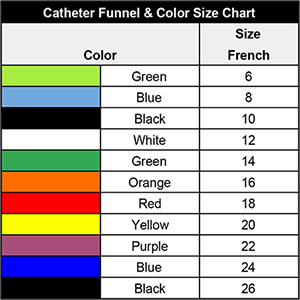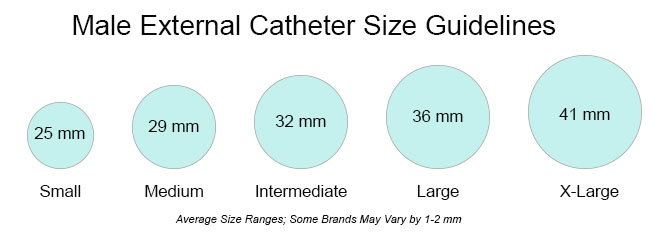
Catheterization may seem scary but it’s actually a routine process that is easy to navigate with the right information. If you are in need of home catheter supplies or guidance on how to choose them, you are in the right place. When it comes to catheter size, the proper fit will prevent unnecessary insertion pain and unpleasant urine leaks. Here you will find everything you need to know to better understand which catheter size you will need.
Understanding French Sizes - Foley and Intermittent Catheters
Most urinary catheter manufacturers use the French gauge system to denote the width of the tube. Typically a Foley or intermittent catheter package will be marked with the letters 'Fr' preceded by a number between 6 and 26. These numbers refer to the diameter of the catheter tube - the smaller the number, the narrower the tube. To convert a French scale size to millimeters, simply divide the number preceding the 'Fr' by three. For example, if the French catheter size is 14 Fr., the actual diameter of the catheter is 4.67mm. To easily identify a catheter size after removal from the packaging, a universal color code on the catheter connector is used by most brands.

Urinary Catheter Types and Sizes
Catheters are categorized into three distinct types: Indwelling catheters, short-term catheters, and external catheters.
Indwelling Catheters: Inserted by a medical professional in a hospital or clinical setting, indwelling catheters enter the bladder through the urethra and typically stay in place for extended time periods. The most commonly used indwelling catheter is the Foley catheter.
Short-Term Catheters: Also called intermittent catheters, this form of self-catheterization is used when patients can independently insert a catheter to void the bladder and is not intended to stay in place. These catheters also follow French sizing. Most medical practitioners will recommend starting adult patients with a 12 Fr. or 14 Fr. size catheter.
Male External Catheters: Known as condom catheters or Texas catheters, external catheters are worn over the penis to collect urine. The sheath, made of silicone or latex, is attached to a tube that transports the urine into a drainage bag. Most external catheter sizes range from small to extra-large and are determined by the circumference of the penis measured in millimeters. External catheters are not invasive, however, the proper fit is imperative to good hygiene.

Female External Catheters: Although male external catheter options are plentiful, female versions are not as common. Most female external catheters on the market today are considered to be 'One-Size-Fits-Most.'
Choosing the Right Catheter Size
If a catheter tube is too large, it may cause pain or create a burning sensation upon insertion and potentially cause tissue trauma resulting in blood in the urine. If a catheter tube is too small, however, you may have trouble draining the bladder as the flow will be restricted. Although it is crucial for your medical practitioner to select the right catheter French size, it is perfectly fine to try a few catheter samples to know which feels best for you. Most patients can successfully adjust the size up or down and will only see a difference in the strength of flow. Keep in mind that catheters that are too small can result in leakage, especially in men.
Male Catheter Size Standards
Male catheter and unisex catheter tubes are approximately 16 inches in length and typically range in width from 14 Fr. to 18 Fr. The most common male intermittent catheter and indwelling catheter French size is 14 Fr.
Female Catheter Size Standards
Female catheter size usually ranges from 10 Fr. to 14 Fr. Of course, every woman is different, but the most common size for adult women is 12 Fr. Female intermittent catheters and other catheter types come in a range of lengths as well to ensure optimal comfort and functionality. Unlike male catheters, female catheters are much shorter, usually about 5 to 6 inches long.
Pediatric Catheter Size Standards
Pediatric catheter size is similar to adult-sizing and based on the unique anatomical needs of both boys and girls. Pediatric catheters range from 5 Fr. to 12 Fr. and are generally about 10 inches long. They come in very narrow sizes to reduce pain and prevent catheterization injury in young children and adolescents.
Note to Intermittent Catheter Users
Once you and your medical practitioner have found the best intermittent urinary catheter size for you, be sure to insert it carefully. Never force it. Instead, gently guide the catheter through the urethra and into the bladder using a catheter lubricant if necessary. If you experience pain or resistance, you may need a smaller size. If the catheter slides in easily, keep an eye on the flow of urine from the tube to ensure your bladder is emptying quickly enough without leaking. If not, you may need a larger tube. Always consult with an experienced medical professional if you have any questions or concerns about at-home catheterization.
To view a comprehensive selection of urological supplies and buy catheters online, visit Allegromedical.com.